
la farge : surf riding at papara, tahiti, 1891
| home | catalogue | history | references | appendix |
 |
surfresearch.com.au
la farge : surf riding at papara, tahiti, 1891 |
|
Reminiscences of the South Seas Doubleday, Page and Company, Garden City, New York, 1901, page 318. Internet Archive
|
and |
South Seas Sketchbooks 1890-191 Sketchbook Number 11, pages 58R-58V Yale Art Gallery
Online
|
"LaFarge's earliest
drawings and landscapes, from his studies in Newport, show marked originality,
especially in the handling of color values.
He was a pioneer
in the study of Japanese art, the influence of which is seen in his work
and presented a lecture, "Hokusai: a talk about Japanese painting," in
New York in 1897.
During his life,
LaFarge maintained a studio at 51 West 10th Street in Greenwich Village,
which now is part of the site of Eugene Lang College at the New School
University.
He made extensive
travels in Asia and the South Pacific, which inspired his painting.
He visited Japan
in 1886, and the South Seas in 1890 and 1891, in particular spending time
and absorbing the culture of Tahiti.
Henry Adams accompanied
him on these trips as a travel companion.
He visited Hawaii
in September of 1890, where he painted scenic spots on Oahu and traveled
to the Island of Hawaii to paint an active volcano."
- John La Farge
(1835-1910)
http://en.wikipedia.org/wiki/John_LaFarge
The Text
Herve Magnificat
notes: "Strangely, La Farge was travelling with historian Henry
Adams, who didnít notice any surf in Tahiti at all, circa Sunday March
23 1891: '... Neither dance nor game have I seen or heard of; nor surf-swimming
...'
Adams, Henry: Letters
of Henry AdamsVolume 1. 1930.
http://www.surfresearch.com.au/1891_Adams_Letters.html
Did he go with La Farge on Papara beach on April 7th morning?"
Adams' comment on
page 476, "neither dance nor game have I seen or heard of, nor surf-swimming,"
is often cited as evidence of the demise of surfriding inTahiti by the
end of the 19th century.
Cleary, Adams' comment
is misleading.
Adams and La Farge
journeyed from Papeete to Papara, on the southern coast, on or about the
26th February, where they stayed for several days.
Here, Adams described
the house of Tati, their host:
"The house stands flat on the seashore, and as I shook hands with Tati, and his old mother and his sister, I caught glimpses of an intense blue sea, through the open doors and windows behind; a sea that came close up to the grass, and had three lines of surf rolling in, through an opening in the reef, and rolling close up till they sent small waves into the entrance of the little river that flows close by the house." -pages 470-471.
While staying with
Tati, Adams was most impressed with "Old Mrs. Salmon" a elderly native
woman who "when she is inclined to talk, she tells us about pagan Tahiti;
old songs, superstitions and customs."
Importantly, she
noted:
"the women ... no
longer dance or swim on the reef.
Long ago, each district
had its professional beauties who were carried about on malangas
and matched with the professional beauties of other districts.
The great swells
made songs for themselves, to be sung when they went out to show their
figures by riding their planks on the surf.
No more beauties
exist." -page 471.
At the end of the
month, Adams and La Farge travelled to Tautira, the residence of
Robert Louis Stevenson located on the south-east coast. Here, Adams, possibly
contemplating the stories of Mrs. Salmon, wrote that he had neither "seen
or heard of ... surf-swimming."
Dated 23rd March,
it is conceivable that at this point neither he or La Farge had not observed
surf riding.
This is perhaps
not unexpected, given the ephemeral nature of suitable surf riding conditions.
The party returned to Papara in early April, Adams described the ceremonial opening of a newly constructed bridge on the 3rd, where "beyond, hardly a stone's-throw away, the surf rolling in miles of foam straight up to our hands." -page 478.
La Farge's report
of surf riding at Papara is dated 7th April, and describes girls swimming
in the mouth of a stream, presumably "the little river" near Tati's house,
while "the boys and one of the men ... were carried along the shore
leaning on their boards."
The comment, "the
currents of the sea carried them past us looking on" seems to imply the
surf riders were riding from the ocean into the mouth of the stream; on
first arriving at Papara, Adams had noted the "small waves (rolling) into
the entrance of the little river."
That these small
waves were now large enough for surf riding, suggests that the outside
swell on this day was significant.
Although Adams had
also returned to Papara (he wrote letters from Papara dated 4th and 8th
April), it appears he may not have been at the beach to witness the surf
riding.
However, it seems
highly unlikely that it was not at least mentioned later in conversation
by the travelling companions.
In preparing his
letters for publication, Adams did not revise his earlier (premature) entry.
The Sketches
Importantly, Herve
Magnificat also noted: "John La Farge also drew some sketches of Paparaís
surfing children" and provided a link to Yale Art Gallery Online.
See below.
La Frage and Adams
in Tahiti, February 4 - June 5, 1891.
The following details
were edited from
Hodermarsky: John
La Farge's Second Paradise, Yale University Press, New Haven, 2010.
| La Farge and Adams
left Apia, Samoa, on 29 January aboard the steamer Richmond.
Arriving at Papeete on 4 February and unable to find hotel, they rent a small cottage. Adams observes that the "imbecile" French administration suppresses many of the native customs, and appears to have superimposed much of French culture onto the Tahitians. After three weeks
in Papeete, where they become familiar with many local identities, they
travelled by wagon on 24 February to pay their respects to Arii Taimai
(known familiarly as Hinarii).
|
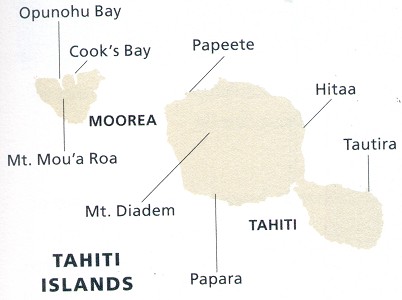 |
On 27 February
La Farge and Adams left Papara for Tautira, on the eastern peninsula of
Taiarapu, arriving that evening.
Whereas Adams finds
little to write about here, La Farge finds plenty of subject matter for
his watercolors, including several studies of the reef at Tautira (Fig.
82 and 83).
They returned to
Papara on the 3 April, and during the week, both La Farge and Adams are
adopted into the Teva family and invested with land. This is a rarely
bestowed honor, as before them, only the Prince of Sweden received a Teva
name.
On the 7 April,
La Farge observes the locals surf riding and made several sketches in his
notebook.
A watercolour, Women
bathing in the Papara River, 1891 (Fig.
89), which appears to show some wave action at the river entrance,
may have been painted at this time.
Two days later they
returned to Papeete and on 12 April, departed for Moorea, the westernmost
island of Tahiti.
Their stay is interrupted
with news of possible passage by steamer to Fiji by way of Auckland, and
they returned to Papeete on the 24.
Unable to secure
a stateroom, they are forced to remain in Tahiti for another six weeks,
residing at the United States Consulate.
During this time,
Adams begins to record the biographies and Tahitian histories as related
to them by Arii Taimai and her daughter, Queen Marau, and on May 16, they
journey to Faa (west of Papeete) for a traditional Tahitian feast at the
home of Queen Marau.
By the end of May,
Marau's memoirs are almost complete, and La Farge and Adams both write
of their growing friendship and enjoyment of
the Teva-Salmon
family.
On June 3 they departed
for Hitiaa, on the eastern coast of Tahiti, and en route stop at Papara
to enjoy a last breakfast with the Teva-Salmons.
Two days later La
Farge and Adams embarked for Fiji aboard the Richmond.
Papara, April 7th 1891.
This is a land
where to live would have made you happy.
Outdoors and
in the water, and in no compulsory dress, would have been your usual way
of passing a great part of the time.
I thought of
you while I looked this morning at the children playing in the water of
the little river, or in the surf that rolls into it or along the shore.
The girls, little
wee things, swam in the stream near its mouth, where it is safe, and plunged
in and out, and swam under water, their feet and backs showing within the
light and dark of the currents; for the river has been very full, and the
surf and tide have been heavy, so that the children take their turn with
the current.
The boys were
out in the surf, on the border of which occasionally the girls played,
edging sideways to it, and running back with swinging arms.
The boys and
one of the men plunged out with surf boards, ducking under or riding over
the waves that did not suit them; then turning just before the wave that
suited, they were carried along the shore leaning on their boards.
The currents
of the sea carried them past us looking on.
Of course they
knew all about them, and
Page 319
rough as the surf
was, one of them had got past one of the lines of the breakers and tried
fishing in some bottom both higher and less vexed.
It was a pretty
sight, the brown limbs and bodies all red in the sun and wet, coming out
of the blue and white water like red flowers.
The girls were
yellower more golden than the boys- less tanned I suppose.
Yale Art Gallery
Online
http://artgallery.yale.edu/lafarge/#/detail/11
While the sketches
appear to be upside down in the sketchbook, they are rotated in the enlarged
views.
Unfortunately, it
appears La Farge did not incorporate any of the surf riding sketches into
the many paintings he made of Tahiti.
The images below
are cropped and darkened to enhance the detail.
Herve Magnificat
also noted:
"He also painted
some studies of reef waves in Tahiti, but without any surfer :
cid:image003.jpg@01CE0FAD.7FB74880cid:image004.jpg@01CE0FAD.7FB74880
Two Studies Of Surf
Breaking On Outside Reef Tautira Taiarapu Tahiti-March1891."
| Page 58R
Inscriptions: Riding the surf
Waves all in light ??? green & white
|
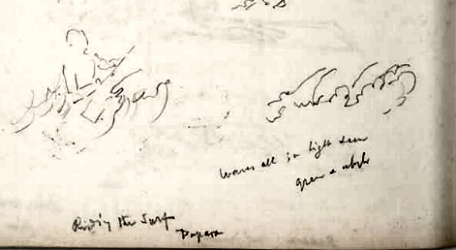 |
| Page 58V
Inscriptions: foam ?? Papara - surf swimming |
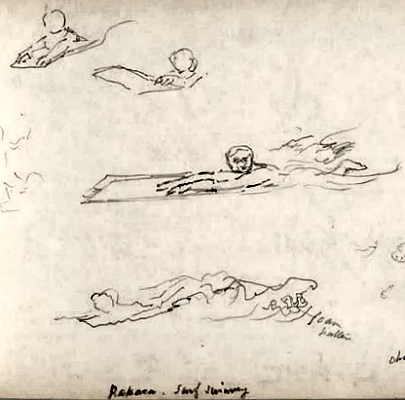 |
|
Women bathing in Papara River, 1891. Watercolor and gouache, 25 1/2 x 23 1/2 in. (64.8 x 59.7 cm). Collection of Jean and Alvin Snowiss. Hodermarsky:
Note that this watercolour appears to show some wave action at the river entrance. |
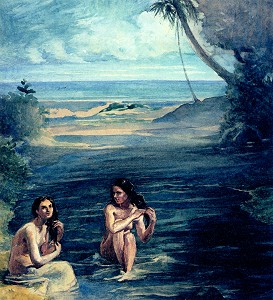 |
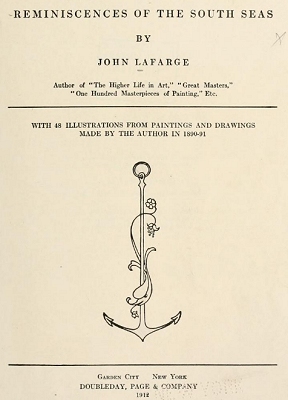 |
Reminiscences of the South Seas Doubleday, Page and Company, Garden City, New York, 1901. Internet Archive
|
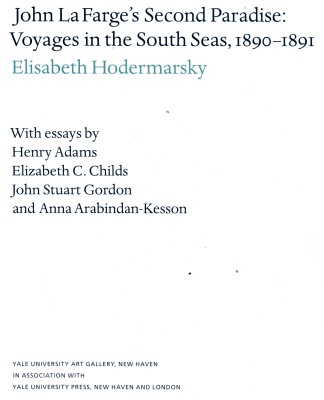 |
John La Farge's Second Paradise: Voyages in the South Seas, 1890-1891. With essays by Henry
Adams
Yale University Art
Gallery
|

| home | catalogue | history | references | appendix |